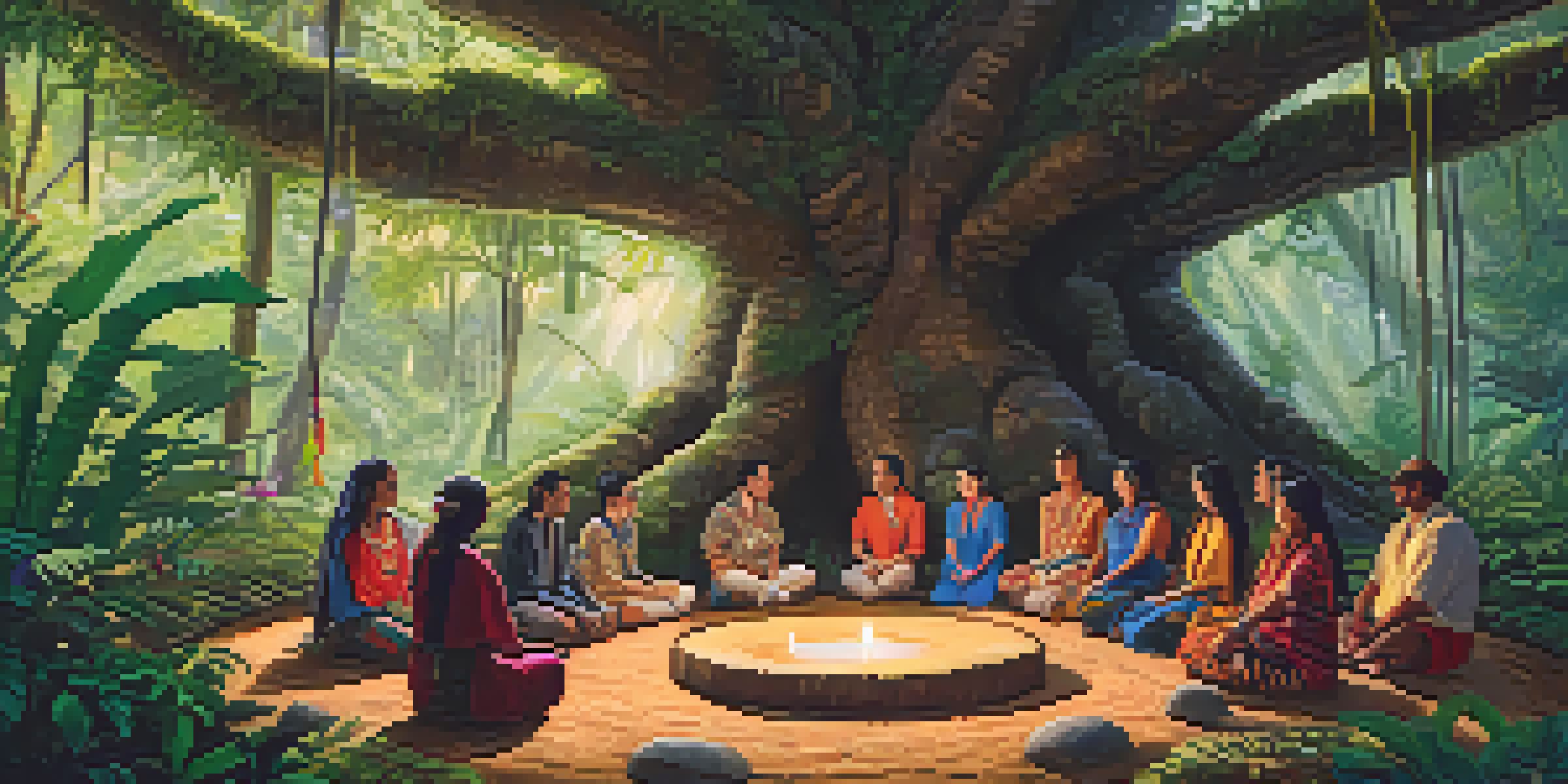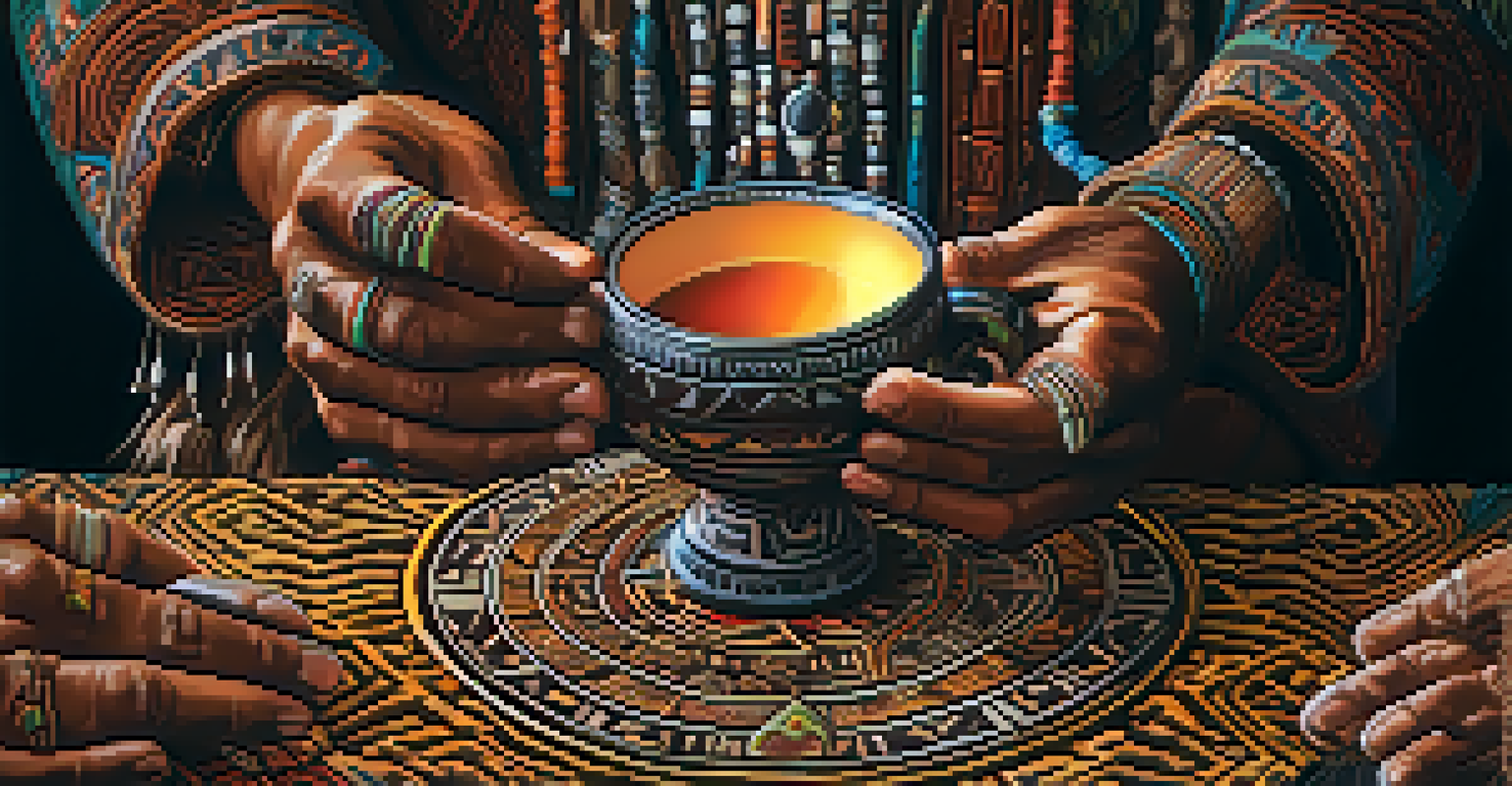Ceremonial Structures: Foundations of Ayahuasca Journeys

Understanding Ayahuasca and Its Cultural Roots
Ayahuasca is a powerful brew originating from the Amazon rainforest, traditionally used in shamanic rituals. It’s made from the Banisteriopsis caapi vine and the Psychotria viridis leaf, which together create a profound hallucinogenic experience. The cultural significance of Ayahuasca is deeply intertwined with indigenous practices, serving not just as a spiritual tool but also as a means of connection to the community and nature.
The use of ritual is to fathom the depths of the soul and to dare to live fully.
In these traditions, the preparation and consumption of Ayahuasca are often accompanied by elaborate ceremonial structures. These structures, which can include sacred spaces, altars, and specific rituals, are designed to foster a safe environment for participants. The rituals surrounding Ayahuasca are as important as the brew itself, guiding individuals through their journeys with intention and respect.
Understanding the cultural roots of Ayahuasca helps to appreciate the importance of these ceremonial structures. They create a framework within which participants can explore their consciousness, guided by experienced shamans who facilitate the process. Ultimately, this deep respect for tradition enriches the entire Ayahuasca experience.
The Role of Sacred Spaces in Ayahuasca Ceremonies
Sacred spaces play a pivotal role in Ayahuasca ceremonies, providing a physical and spiritual environment conducive to healing. These spaces are often adorned with symbols, natural elements, and offerings that resonate with the participants' intentions. The atmosphere created within these spaces allows individuals to feel connected not just to themselves, but to the universe around them.

The design of these spaces varies, but they often include a central area for the ceremony, surrounded by natural elements like trees and plants. This connection to nature enhances the experience, making participants feel grounded and open to the insights offered during the journey. The use of natural materials also reinforces the idea of harmony with the environment, a core principle in many indigenous cultures.
Ayahuasca's Cultural Significance
Ayahuasca is deeply rooted in indigenous traditions, serving as a spiritual tool that fosters community and connection to nature.
Furthermore, the layout of the sacred space is intentionally crafted to facilitate the flow of energy. This careful consideration helps participants to focus on their inner work while feeling supported by the collective energy of the group. By creating a safe and sacred space, participants can immerse themselves fully in the transformative experience of Ayahuasca.
The Importance of Rituals in Ayahuasca Ceremonies
Rituals are the backbone of Ayahuasca ceremonies, providing structure and meaning to the experience. These rituals often involve singing, chanting, and the use of traditional instruments, all of which serve to elevate the spiritual atmosphere. Each element of the ritual is designed to guide participants through their journeys, helping them to navigate the emotional and psychological landscapes they may encounter.
An experience can be transformative when it is shared with others, as it creates a community of healing.
One common practice is the 'Icaro,' a song sung by the shaman that is believed to carry healing energies. These songs can evoke powerful emotions and facilitate connections to the spirit world, enhancing the overall experience. The repetition of rituals not only creates a sense of familiarity but also deepens the connection between participants and the ceremonial process.
Moreover, rituals help to establish a sense of community among participants. As individuals engage in shared practices, they bond over their experiences, creating a supportive network that extends beyond the ceremony. This communal aspect reinforces the idea that healing is not just an individual journey, but a collective one.
How Intentions Shape the Ayahuasca Experience
Setting intentions is a crucial aspect of the Ayahuasca journey, as it helps to focus the mind and spirit. Participants are often encouraged to reflect on what they hope to gain from the experience before the ceremony begins. This practice not only clarifies their goals but also aligns their energies with the broader purpose of the ritual.
Intentions can range from seeking personal healing to gaining insights about one’s life path. By articulating these intentions, individuals create a personal roadmap for their journey, guiding them through the sometimes turbulent waters of their subconscious. The clearer the intention, the more profound the insights that can emerge during the ceremony.
Role of Rituals in Healing
Rituals provide structure and meaning to Ayahuasca ceremonies, enhancing participants' emotional journeys and fostering a sense of community.
Additionally, the communal aspect of setting intentions fosters a sense of shared purpose among participants. When everyone is aligned with their intentions, the collective energy amplifies the potential for transformation. This shared focus creates a powerful environment for healing, where individuals feel supported in their explorations.
The Role of the Shaman in Ayahuasca Ceremonies
The shaman acts as a guide and facilitator during Ayahuasca ceremonies, playing a vital role in the overall experience. With years of training and experience, shamans navigate the spiritual landscape to help participants through their journeys. Their wisdom and knowledge of the brew, as well as the rituals, are essential for ensuring a safe and meaningful experience.
Shamans are attuned to the energies in the room, allowing them to respond to the needs of participants during the ceremony. They often sing Icaros, which not only enhance the healing process but also provide comfort and reassurance. This connection between the shaman and participants creates a sacred bond that deepens the transformative power of the experience.
Moreover, the shaman’s presence serves as a grounding force, helping participants to feel safe as they explore challenging emotions and insights. This supportive role underscores the importance of having an experienced guide during such profound journeys. The shaman’s expertise can turn a potentially overwhelming experience into a journey of healing and understanding.
Aftercare: Integrating the Ayahuasca Experience
Aftercare is an often-overlooked aspect of the Ayahuasca journey, yet it is crucial for integrating the insights gained during the ceremony. Following the intense experiences, participants may feel vulnerable and need support as they process their journeys. This phase is about taking the lessons learned and applying them to everyday life, ensuring that the benefits of the experience continue.
Many shamans and facilitators provide aftercare support, which can include sharing circles, counseling, or resources for further exploration. These practices help participants articulate their experiences and emotions, making sense of the often profound revelations encountered during the ceremony. This integration process is vital for personal growth and healing.
Importance of Intention Setting
Setting intentions before the ceremony creates a personal roadmap that guides participants through their transformative experiences.
Furthermore, the community formed during the ceremony can be a source of ongoing support. Participants often stay connected, sharing their experiences and insights long after the ceremony ends. This sense of community reinforces the idea that healing is a journey best taken together, not alone.
Conclusion: The Lasting Impact of Ceremonial Structures
Ceremonial structures in Ayahuasca journeys are not merely physical arrangements; they are integral to the entire experience. They provide the framework within which healing, connection, and transformation occur. Understanding their significance can deepen one’s appreciation for the ritualistic aspects of Ayahuasca, enhancing the overall journey.
Through sacred spaces, rituals, intentions, and the guidance of shamans, participants embark on a profound exploration of self. These elements work together to create a holistic experience that is both individual and communal. The lasting impact of these ceremonies can lead to significant personal growth and a renewed appreciation for life.

Ultimately, the ceremonial structures surrounding Ayahuasca journeys highlight the importance of tradition, community, and intentionality in the healing process. By respecting and understanding these foundations, individuals can navigate their journeys with greater clarity and purpose, transforming their experiences into meaningful life lessons.